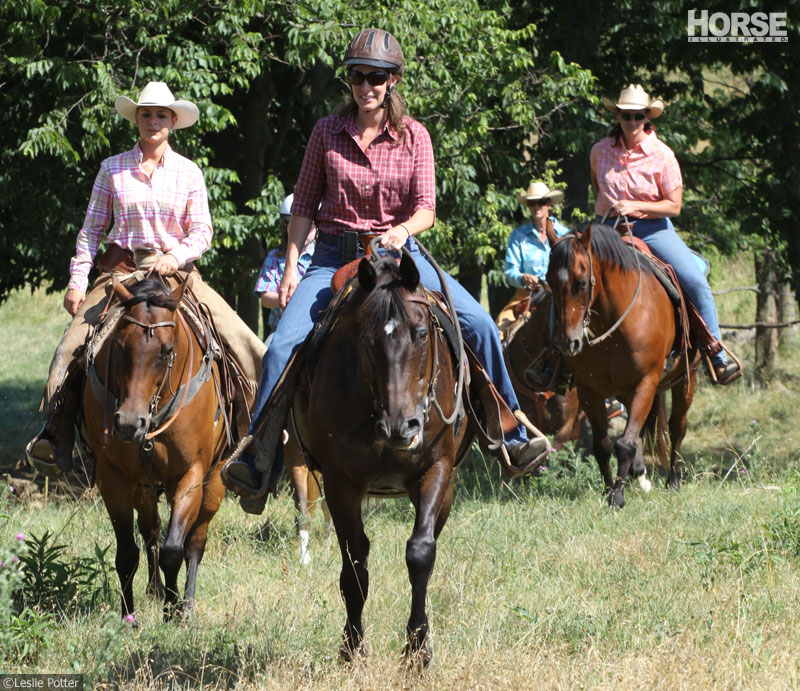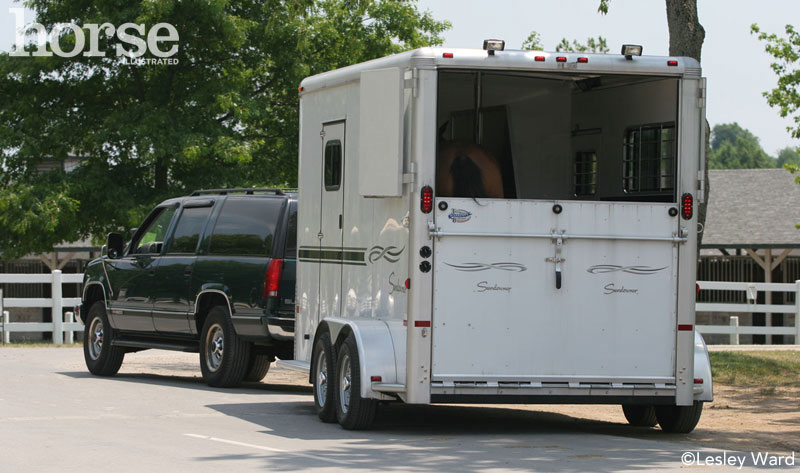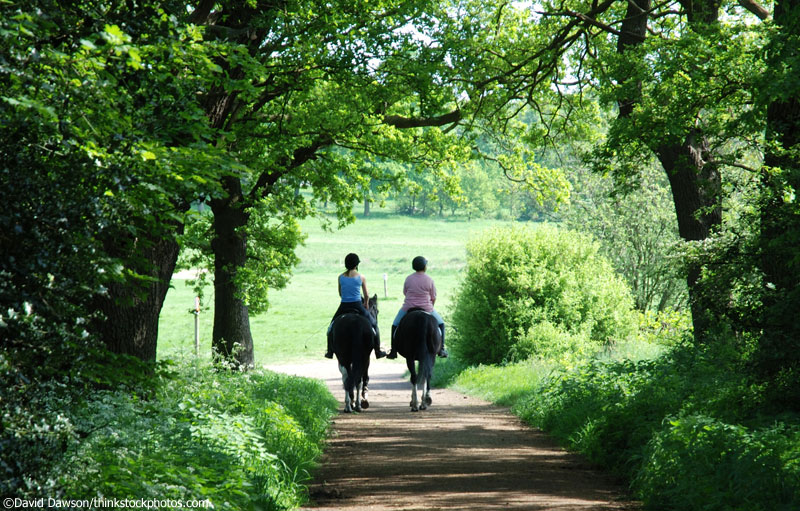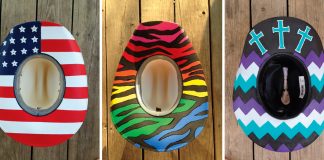It’s no wonder that trail riding is the most popular equestrian activity. Riding a great trail on a good horse is an amazing way to spend the day. To ensure your trail ride is a glorious adventure and not an unpleasant outing, it’s important to know what you are doing. A day in the wilderness can be challenging if you aren’t prepared. Before you head out with your horse, keep the following tips in mind.

1. Choose your ride.
Before you decide where you are going to ride, think about whether you and your horse are up for the trek. If your horse is very young, very old, or just inexperienced, choose a trail that won’t be too physically challenging or too long. Think about the level of exercise your horse is used to, and plan to do only that much.
In the summer, choose a trail with plenty of shade. It’s easy for you and your horse to become overheated, especially if you aren’t used to exerting yourselves in the heat. Also look for a trail with water crossings so your horse can stop and drink if he gets thirsty.
2. Prepare your horse.
If your horse isn’t a veteran trail mount, make sure he’s completely controllable in the arena before you take him in out in the wilderness. If you want to go on trail rides of an hour or more, or plan to do more than walk on flat ground on your ride, begin conditioning your horse at least two months before your outing.
If your horse is sound and healthy and has been receiving regular exercise, you can start with increasing his time under saddle in 15-minute increments each week. For example, if you have been riding him three times a week for 45 minutes each, increase that to three times a week 60 minutes each time. You can also add another day of exercise to his routine.
If you are planning to go on an all-day ride, train up to about half the time you intend to ride on trail day. Do this by gradually building up the time you spend out on trail, slowly adding more time to the rides.
3. Check your tack.
Before loading your tack into the trailer for your trip to the trailhead, give your saddle and bridle a once-over. You want to make sure all your equipment is in good working order so you don’t end up with a serious problem out on the trail. Check your girth and stirrup leathers to make sure they are free from cracks and tears, and do the same for your bridle. Tighten bridle screws, and look over your headstall to verify that the leather is not torn in areas of stress.
Examine your saddle pad and girth to be sure they are clean and free from dirt and debris that could irritate your horse on a long ride.

4. Check your trailer.
Before you load your horse up into your trailer, perform a safety check. Hitch up the trailer and test the brake lights and turn signals to make sure they are working. Examine the hitch to make certain it is secure, and that the chains are attached. Check the tire pressure when the tires are cold to verify that it’s correct.
Inside the trailer, inspect the divider panels to see that they are securely mounted to the trailer wall. Check the interior for sharp edges or loose wires; your horse can get into trouble with these.
Sweep out old bedding and manure, and inspect your trailer floor under the mat. You want to be certain your floorboards are in good shape and free from rot. Remember to add a low-dust bedding to the trailer floor before loading your horse to help absorb urine and manure. This will help keep the floor from becoming slippery for your horse.
Hang a full hay net inside the trailer or put a flake of hay in the trailer manger so your horse can eat during the drive.
5. Pack for your horse.
The items you pack for your horse will depend on how far you are driving to your destination and how long you will be gone. For both long and short trips, remember to bring grooming tools, such as a currycomb, body brush and hoof pick. If you’ll be riding in an area where insects are a problem, bring bug repellent for your horse, along with an ear bonnet or a fly mask.
Remember to pack your saddle, bridle, breast collar or crupper, girth and saddle pad. Bring along a halter and lead rope your horse can wear on the trail—you never know when you may need to safely tie your horse while you are out on your ride. If your horse wears hoof boots, remember to pack these as well.
A sharp pocket knife and a hoof pick are essentials on the trail, so be sure to pack these items so you can take them along when you ride.
If you plan to linger at the trailhead or staging area before or after your ride, bring along some hay for your horse to eat. Remember to bring a bucket for water too. Find out ahead of time if water will be available at the trailhead or along the trail. Bring at least a 5-gallon jug of water from home to offer to your horse.
6. Pack for yourself.
Carrying a saddlebag is a good idea if you’ll be riding for more than an hour. You can use the saddlebag to carry lip balm, sunscreen, bug repellent, tissues, a trail map and your camera. You can even bring your lunch along.
Remember to bring a fully charged cell phone with you, along with a phone case that clips to your belt. It’s best to carry your phone on your body instead of in your saddlebag in case you happen to get separated from your horse while on the trail.
Don’t forget to pack key riding gear, which may include chaps, a helmet, gloves and sunglasses. Be sure to check the weather forecast, and bring a helmet visor, wide-brimmed hat, rain poncho, warm coat, gloves, or whatever you need to be comfortable while you are outdoors for several hours.
7. Know your way.
Before you head out from the trailhead, be sure you know where you are going. Bring along a trail map, and study it first. If you have a GPS device, determine the coordinates of your starting point so you can easily get back to your trailer if you happen to get lost.
If the area where you’ll be riding is part of a state or regional park, get information from the rangers who manage the area. Talk to them about the trail, and ask about suitability for horseback riding. Some trails are permitted for equestrian use, but can be quite treacherous for horses. Ask about mountain bikers and backpackers too. If your horse isn’t used to bikes coming at him or behind him, or gets nervous around hikers with large orange packs strapped to their backs, you might want to consider choosing a different trail.

8. Choose the right partner.
It’s always a good idea to ride with other people when you go out on the trail, but it’s important to choose the right people for the ride. You want to buddy up with riders who have a sense of trail safety and etiquette. Riding with someone who has a very different idea of fun than you can result in both of you having a lousy time.
If you’ve never ridden with a particular person, ask a few basic questions to determine if your trail styles are compatible. Start by asking what kind of pace she likes to maintain on the ride. Does she prefer a leisurely walk? Does she want to trot now and then? What about cantering or galloping? Find out about her horse, too. Ask how old he is, how he acts on trail (calm or nervous) and whether he is relaxed around other horses. The answers to these questions will help you determine whether this is the right person for you to take along on a ride.
9. Set your pace.
Before you head out on the trail, figure out how long you want to be out, and set your pace accordingly. Keep in mind that a horse typically walks at 3.5 to 4 mph, trots at 8 to 10 mph, and canters at 10 to 17 mph. Think about how many hours you want to ride and how far you want to go in that amount of time. For example, if the trail you plan to take is a 10-mile loop, you will need about 4 hours to complete this distance at a leisurely walk. If you want to get it done faster, you’ll need to spend some time trotting and possibly cantering.
When determining your pace, keep your horse’s condition in mind. The faster you go, the more taxing the ride will be on your horse. Be careful not to overwork your horse. If you don’t have time to complete the entire trail loop, cut the ride short rather than pushing your horse past his physical limits.
10. Reward your horse.
Once your ride is over, take good care of your horse. Cool him out thoroughly, walking slowly until his breathing and heart rate return to normal. Hose or sponge him with cold water if it’s a hot day and he has worked up a sweat. Before you put him back in his stall or pasture, give him a good grooming, examining him for any cuts or hot spots on his legs, and soreness on his back. If you find any problem areas, apply wound ointment or liniment to help ease his discomfort. If you detect back soreness, check the saddle to make sure it’s a proper fit.
If your ride was long, give your horse some extra hay to make up for the calories he burned during the day. Don’t forget to throw in some carrots or horse treats, just as a “thank you” for a great ride.
Liked this article? Here’s more trail riding advice:
7 Tips to Help Save Horseback Riding Trails
The Trail Rider’s Social Network
Trail Riding Etiquette
AUDREY PAVIA is an award-winning freelance writer and the author of Trail Riding: A Complete Guide and Horses for Dummies. A former editor of Horse Illustrated, Audrey lives in Norco, Calif., with her two Spanish Mustangs, Rio and Milagro.
This article originally appeared in the April 2014 issue of Horse Illustrated. Click here to subscribe.







Great trail riding tips! Thanks!
cool
Good advise, great tips.
great tips
Nice tips i like number 8 choosing the right riding partner. Thanks!